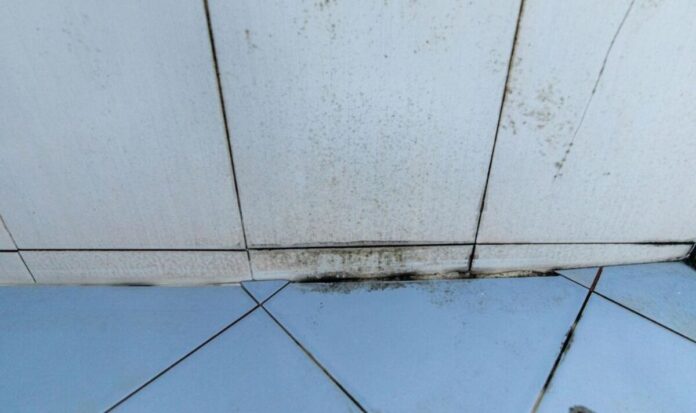One of the most common places to find mould is between tiles as the porous nature of grout is highly susceptible to microscopic growth. Another place you can find mould is in shower grout. Whether part of a kitchen backsplash or bathroom detail, tiles usually see a ton of moisture. Rarely do homeowners take the time to dry tiles or the grout between them completely after cooking or washing. If a damp room has inadequate ventilation and you don’t run a fan or dehumidifier, it quickly becomes the right environment for mould. Removing mould from the grout between tiles can be tedious, but it’s well worth it to avoid mould-related illnesses. Taking to a Mrs Hinch inspired cleaning page on Facebook one woman asked for advice on how to remove mould in her bathroom, specifically on areas of grout.Jade white wrote: ‘What’s the best way to clean this mould on the sealant and grout please?’Due to the levels of moisture in the air, mould is very often found around windows and in bathrooms, commonly collecting in the space between your tiles. As one of the most likely manifestations of mould in your home, tackling mould in the grout between bathroom tiles is a universal problem.Depending on the tiles homeowners have chosen, they should avoid using abrasive cleaning agents like bleach as this can potentially ’cause permanent damage to the surface and colour of the tiles’, says tile experts and Eurotiles & Bathrooms.READ MORE: I tried the white vinegar and newspaper hack to clean my windows ‘Never comes back!’ ‘Must-have’ staple to banish mould from grout without causing damage (Image: GETTY)Fortunately, cleaning enthusiasts have suggested ways to remove grout without damaging tiles. The most common solution recommended was to use baking soda.Jinny Ross said: ‘I create a paste from baking soda and water, then leave it on the mouldy area for 10 minutes. After that the mould will be gone and there’s no damage to the tiles.’Annie Saunders commented: ‘Easy. Use baking soda, it’s less harsh than bleach and I even think it does a better job. I do this once a week and it never comes back again.’Marie Collins wrote: ‘Make a paste from baking soda and water and leave it on for a couple of minutes and then rinse. Works well for me.’DON’T MISS’Cheaper’ time to run washing machines to save money on laundry [EXPERT]ITV News At Ten’s Tom Bradbury’s quiet life in rural Hampshire town [INSIGHT]Remove ‘stubborn’ brown stains from oven door with ‘miracle’ item [TIPS] The most common solution recommended was to use baking soda (Image: GETTY) If baking soda alone isn’t quite cutting it, the pros advised adding hydrogen peroxide (Image: GETTY)They said: ‘Apply the baking soda as above, except in this instance pour over the hydrogen peroxide until the paste begins to bubble. ‘This will assist with loosening the mould.’ As with the baking soda application, rinse with warm water and repeat if necessary.Experts at Service Master Clean also suggested using the baking soda method. They said: ‘Baking soda is a stellar lifting agent. To make a paste that you can spread over mould to lift it, stir together half a cup of baking soda and several teaspoons of water. ‘Adjust the combination until you have an easily spreadable consistency. Apply the baking soda paste directly over the mouldy grout, let sit for 10 minutes, then scrub the mould away with a bristle brush. Rinse with water, and repeat as needed.’
‘Must-have’ staple to banish mould from grout without causing damage
Sourceexpress.co.uk
RELATED ARTICLES


